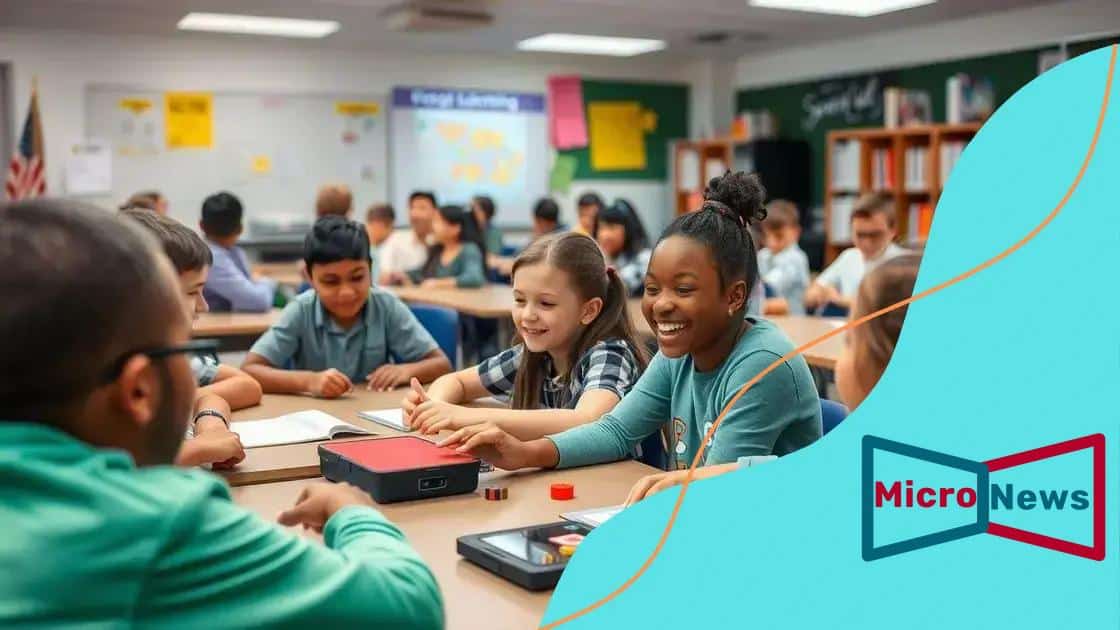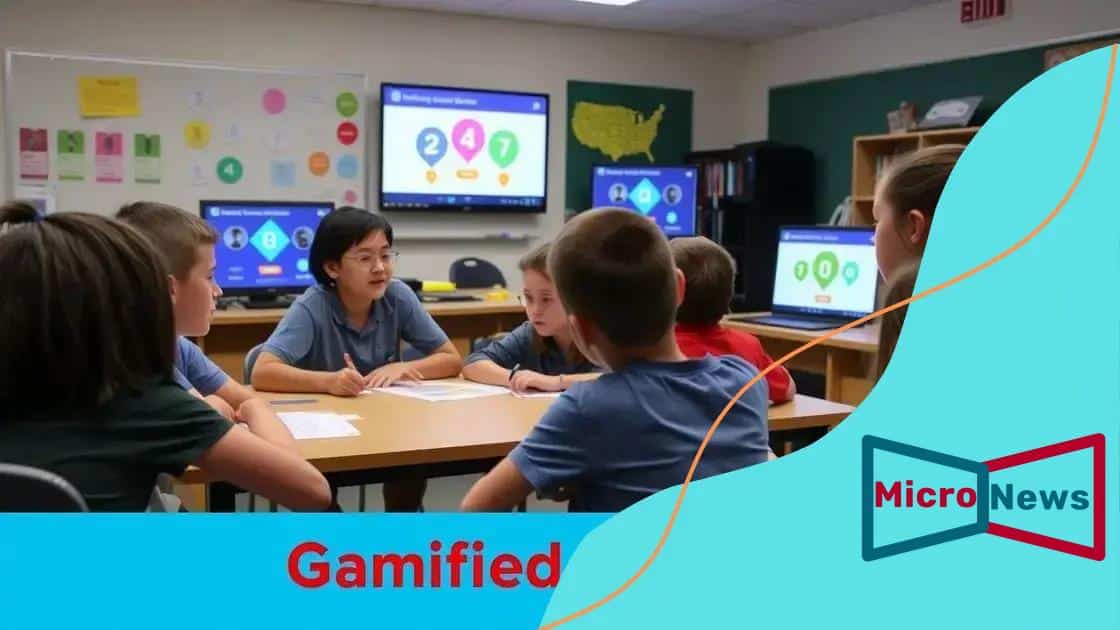Gamification in K-12 classrooms: engage students effectively

Gamification in K-12 classrooms enhances student engagement and motivation by integrating game design elements into lessons, resulting in a more dynamic and interactive learning experience.
Gamification in K-12 classrooms is reshaping the way students interact with their lessons. Imagine a classroom where learning feels more like playing a game. This approach can truly make education exciting and effective. So, how can teachers leverage this trend?
Understanding gamification in education
Understanding gamification in education is crucial for creating dynamic learning environments. It combines elements of play and competition into the classroom, enhancing student engagement and motivation. This approach transforms traditional learning methods into interactive experiences that resonate with today’s learners.
What is Gamification?
Gamification involves applying game-design elements to non-game contexts. In education, this means incorporating points, badges, and leaderboards into the learning process. By doing so, educators can motivate students and encourage them to participate actively in their learning journey.
Benefits of Gamification in Education
- Improves student engagement and participation.
- Enhances motivation through rewards and achievements.
- Encourages collaboration and teamwork.
- Facilitates personalized learning experiences.
As students engage with educational material in a game-like environment, they are more likely to retain information and develop critical thinking skills. Gamification gives students the freedom to explore topics creatively, fostering a sense of ownership over their learning process.
Furthermore, it helps teachers track progress more effectively. With clear metrics for success, educators can identify areas where students may need additional support. This adaptability makes gamification a powerful pedagogical tool that addresses the diverse needs of learners.
Key benefits of gamification for students
The key benefits of gamification for students are quite significant. This innovative approach to learning encourages student participation and enthusiasm. It turns traditional lessons into engaging experiences, making education feel more like a game than a chore.
Enhancing Engagement
Gamification enhances student engagement by incorporating fun elements. When students feel like they are playing a game, they become more invested in their learning. This means they pay attention and participate more actively in lessons.
Motivation through Rewards
Another major benefit is the motivational aspect. By earning points, badges, or leaderboards, students are encouraged to achieve their goals. Rewards create a sense of accomplishment and push students to strive for excellence.
Moreover, gamification fosters a positive learning environment. When students are excited to learn, they are more likely to collaborate with peers and try new challenges. This helps to develop social skills and teamwork.
- Promotes active participation and interaction.
- Creates a sense of achievement and progress.
- Fosters a collaborative learning atmosphere.
- Encourages risk-taking in a safe environment.
In addition, gamification helps in personalized learning. Each student can progress at their own pace, allowing for tailored learning experiences. This adaptability benefits diverse learners by addressing their individual needs. As a result, students feel more confident and empowered in their educational journey.
Strategies to implement gamification

Implementing gamification in the classroom can transform student experiences significantly. There are several effective strategies that educators can use to make learning more engaging and enjoyable for students.
Start with Clear Goals
Before diving into gamification, it’s essential to define clear learning objectives. Establish what you want students to achieve and how gamification will help reach these goals. This creates a foundation for using game elements effectively.
Choose the Right Game Elements
Not all game elements work for every subject or age group. Select elements that resonate with your students. Consider using points, badges, or leaderboards to motivate students. Also, integrate storylines or challenges to enhance engagement.
- Points systems for tracking progress.
- Badges for accomplishments and mastery.
- Leaderboards to foster healthy competition.
- Story-driven challenges to captivate interest.
As you implement these strategies, provide regular feedback. Feedback is key in gamification as it informs students about their progress. Positive reinforcement can boost motivation and encourage students to keep trying.
Additionally, encourage collaboration among students. Group activities and team-based challenges can enhance the gamified experience. When students work together, they develop important social skills and learn from each other’s strengths.
Real-world examples of gamification
Real-world examples of gamification showcase its effectiveness in making learning fun and engaging. Schools and organizations around the globe have implemented gamified strategies, leading to impressive results.
Examples in Education
Many educators have adopted gamification to enhance student learning. For instance, a school might use a points system where students earn points for completing assignments or participating in class discussions. This motivates students to stay engaged.
Common Platforms
Platforms like Kahoot and Classcraft have gained popularity. Kahoot allows teachers to create quiz-based games that students can join using their devices. Classcraft adds a role-playing element, where students choose characters and work in teams to overcome challenges.
- Kahoot: A fun, interactive quiz platform.
- Classcraft: Combines learning with gaming elements.
- Duolingo: A language-learning app that uses gamification to encourage practice.
Corporate training programs also utilize gamification to improve employee engagement. Companies use simulations and challenges to teach new skills. Employees can earn rewards, making the training experience enjoyable. This approach has shown to boost knowledge retention and improve performance.
For example, IBM uses gamification to enhance software training. Employees participate in competitions that allow them to earn badges for mastery of skills. This not only keeps them engaged but also fosters a sense of achievement.
Challenges and tips for teachers
Implementing gamification in the classroom can be exciting, but it also comes with its challenges. Teachers may face obstacles that make it difficult to fully embrace this approach. Understanding these challenges and learning how to overcome them is crucial for success.
Common Challenges
One significant challenge is the varying levels of student engagement. Some students might thrive in a gamified environment, while others may struggle. Teachers need to find ways to ensure all students feel included and motivated.
Resource Limitations
Another challenge arises from limited resources. Not all schools have access to technology that supports gamification. Teachers may need to be creative, using available tools to create engaging experiences.
- Using low-tech solutions, like paper-based games.
- Incorporating group projects that mimic game elements.
- Using existing platforms that offer free gamified content.
Time management is also a concern. Designing gamified lessons can require extra time for preparation. Teachers should seek to balance traditional lesson planning with the creativity needed for gamification.
To address these challenges, teachers can implement a few effective tips. First, start small. Introduce one or two gamified activities instead of overhauling the entire curriculum. This allows students to adjust gradually and gives teachers the chance to evaluate what works best.
Feedback is essential. Regularly ask students for their thoughts on the gamified elements. This information can be invaluable in tweaking the approach to better meet their needs.
FAQ – Frequently Asked Questions about Gamification in K-12 Classrooms
What is gamification in education?
Gamification in education involves using game design elements to enhance learning experiences, making lessons more engaging and interactive.
How can gamification benefit students?
Gamification can boost student motivation, increase engagement, and promote collaboration among peers, leading to a more impactful learning experience.
What challenges do teachers face when implementing gamification?
Teachers may encounter challenges like varying student engagement, resource limitations, and time management when incorporating gamification into their curriculum.
Can you give examples of gamification tools for the classroom?
Yes, tools like Kahoot, Classcraft, and Duolingo are popular for gamifying lessons, allowing teachers to create interactive quizzes and activities.





